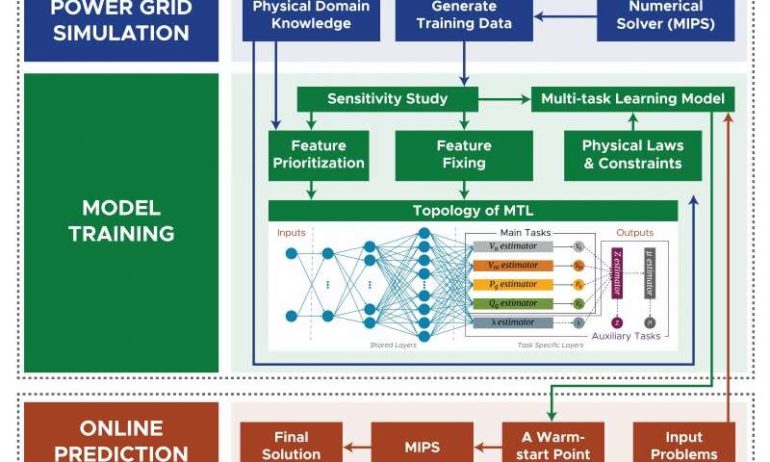Most modern phones and cars are programmed to “learn” from their environment—sounds, facial features, and even common driving routes. Patterns of recognition allow these systems to accurately predict and suggest preferred options in the blink of an eye.
Now imagine a system that could provide the same precision and responsiveness for critical national challenges, such as disease diagnoses, weather forecasting, and power grid reliability.
A new software application called the Smart Power Grid Simulator (Smart-PGSim) uses neural networks, a type of artificial intelligence (AI), to efficiently solve power grid simulations crucial for planning and optimizing electricity delivery. Initial test results showed Smart-PGSim solved power flow calculations about three times faster than a traditional numerical model, without a loss in precision.
Developed by Pacific Northwest National Laboratory (PNNL) computer scientist Gokcen Kestor and collaborators from the University of California, Merced, the methodology behind Smart-PGSim uses a novel neural network approach called multi-task learning modeling. The researchers believe it is the first such application of AI for the power grid.
“Advances in AI and high-performance computing in the last several years allowed us to explore this method,” said Kestor, a researcher in PNNL’s Advanced Computing, Mathematics, and Data Division. “We could not have developed this approach five or ten years ago.”
Kestor will virtually present the team’s research in November during Supercomputing 2020, the world’s largest annual gathering of professionals in the fields of high-performance computing, networking, storage, and analysis.
Compared to a current power flow simulation tool, Smart-PGSim worked nearly three times faster with far fewer iterations and nearly the same accuracy. (Animation by Cortland Johnson | Pacific Northwest National Laboratory)
Overcoming challenges of scale, efficiency, and accuracy
To keep power flowing at optimum levels, grid operators use offline computer models that crunch data based on a range of scenarios. It’s an iterative process that occurs over and over, all day, every day, and is critical for maintaining grid stability and reliability.
The models must account for highly variable power sources, such as wind and solar, possible power grid failures, and many other contingencies including unexpected increases or decreases in power demand or generation. Depending on the region, the number of power generators alone can range from 1,000 to 1,000,000. Connecting this array of inputs presents an enormous challenge for predictive power grid simulations.
Processing all the data and quickly making sense of it requires a level of programming sophistication on par with the most agile machine of all—the human brain.
Multi-task learning for power grid simulations
Neural networks mimic the way the human brain makes connections in complex relationships through a series of stimulus and activation neurons. Each stimulated neuron activates another neuron and so on, refining the relationship to arrive at meaning. Similarly, using AI neural networks, a computer program can learn to automatically make connections between related layers of data and quickly converge on a solution.
For Smart-PGSim, the research team integrated grid-specific domain knowledge into the layers of a multi-task learning model. Physical system constraints, such as generator power, line flow range, and voltage limitations were key to training the model and improving the accuracy, interpretability, and defensibility of the solutions predicted by the model.
“Compared with traditional single-task models, our multi-task model improves accuracy while simplifying the training process,” said Wendy Dong, a University of California, Merced doctoral intern in PNNL’s High-Performance Computing group who worked closely with Kestor throughout the yearlong project. Dong said a well-trained, offline multi-task learning model “can generate a high-quality starting point for online simulation tools to achieve quick convergence.”
Other computational approaches replace a numerical solver with a neural network-based approximation to speed the time-to-solution. However, the approximation degrades the feasibility of the solution—or optimal computational convergence.
“Losing the optimality of computational convergence may translate to a loss of millions of dollars or lack of electricity in critical points, such as hospitals,” said Kestor. “The novelty of our approach is that a neural network is paired with a numerical solver that guarantees the final solution will not lose feasibility.”
Accelerating AI solutions for national priorities
The new application stems from work conducted through the Center for Artificial Intelligence-focused Architectures and Algorithms (ARIAA) funded by the U. S. Department of Energy’s Office of Science, and the Center for Advanced Technology Evaluation funded by DOE’s Office of Advanced Scientific Computing Research. A shared goal of the two centers is to accelerate scientific computing to reduce bottlenecks in power grid simulations.
While initial results from Smart-PGSim show promising speed, the research team believes that even further improvement is possible through custom hardware AI engines, such as those developed through ARIAA, and by automating some of the manual design work. Such enhancements could allow Smart-PGSim to tackle different applications without the need for an AI engineer to design the neural network.
Kestor emphasized the generality of the techniques the team customized for Smart-PGSim.
“These techniques can be broadly applied to many scientific high-performance computing applications, not just the optimization problem in power grid simulations,” said Kestor. “Other potential applications could include fluid dynamic simulation, molecular dynamics simulation, and cosmology modeling.”
Scientists use artificial intelligence in new way to strengthen power grid resiliency
More information:
Dong et al., Smart-PGSim: Using Neural Network to Accelerate AC-OPF Power Grid Simulation. International Conference for High-Performance Computing, Networking, Storage, and Analysis (2020). DOI: 10.1109/SC41405.2020.00067
Provided by
Pacific Northwest National Laboratory
Citation:
Researchers speed power grid simulations using AI (2020, November 10)
retrieved 10 November 2020
from https://techxplore.com/news/2020-11-power-grid-simulations-ai.html
This document is subject to copyright. Apart from any fair dealing for the purpose of private study or research, no
part may be reproduced without the written permission. The content is provided for information purposes only.



